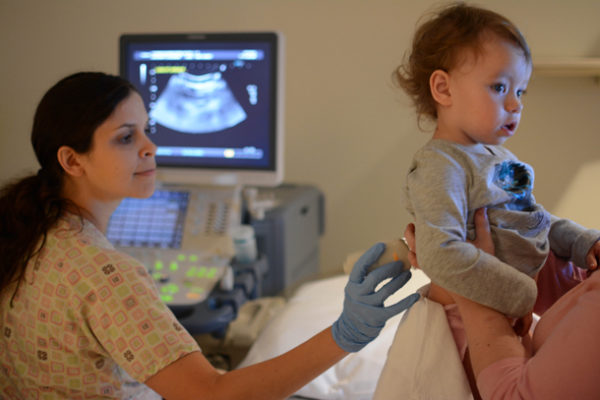What is a Radiologic Technologist?
Radiologic technologists are medical professionals who use their expertise and knowledge of patient care combined with radiologic techniques to take images. In simpler terms, they use a special camera to look inside of the patient’s body to diagnose a problem.

Radiologic technologist is a general term applying to technologists who take pictures with many different types of cameras. The technologists at Cincinnati Children’s Hospital often focus on one type of imaging using a single type of camera. The different types of imaging are described below.
- Diagnostic Radiography (X-Ray) uses controlled radiation to examine internal organs and bones from a one-dimensional point of view.
- Fluoroscopy is live controlled x-ray usually used to look at the digestive system or the urinary system. At Cincinnati Children’s Hospital, fluoroscopy is also used to help position tubes or lines within the body. Technologists who perform diagnostic radiography also help to perform fluoroscopy.
- Ultrasound (Sonography) uses sound to bounce off of objects and create images like sonar or radar. Ultrasound is usually used to look at internal organs or vessels.
- CT (Computed Tomography) uses controlled radiation to take pictures of the body in thin slices. The slices are lined up, one after the other, to take pictures of an entire body part (like slices of bread all put together to make a loaf). CT can provide information in either two or three dimensions.
- MRI (Magnetic Resonance Imaging) uses powerful magnets to create images. The magnets can be used to highlight different tissue types within the body. MRI can provide information in either two or three dimensions.
- Nuclear Medicine uses small amounts of radioactive tracers to examine how specific organs or cell types function.
- Interventional Radiology uses fluoroscopy, CT, and ultrasound to help guide minimally invasive surgery.
Radiologic Technologists receive their education through a two- or four-year degree program. A technologist’s training provides extensive hands-on clinical experience. After graduation the technologist must pass a board exam in order to practice in the field.

The Radiologic Technologists at Cincinnati Children’s all go a step beyond their education and training in order to specialize in working with children. Through continuing education, our technologists are always up-to-date on cutting edge technologies and techniques; this helps us maintain the highest level of standards and safety. If you choose to have your child’s test performed at Cincinnati Children’s, you can be assured that the technologist taking care of you is the most capable in the industry.
